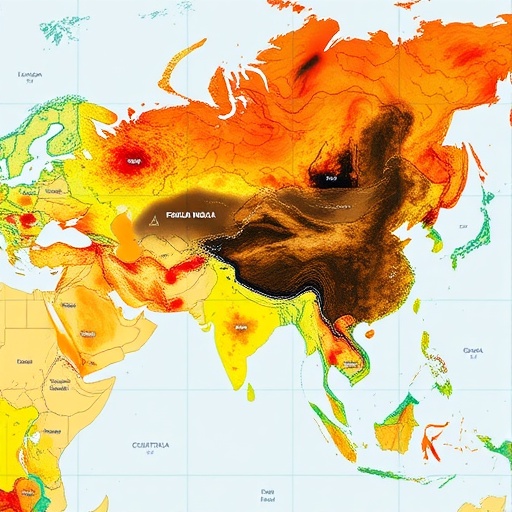A groundbreaking genomic study has unveiled a profound and intricate history intertwining humans and their canine companions throughout Eurasia spanning over the last 10,000 years. By meticulously analyzing ancient dog genomes alongside those of their human counterparts, researchers have traced how genetic signatures of distinct dog populations parallel the movement and cultural transformations of diverse human societies across this vast region. This remarkable discovery not only illuminates the longstanding biological and cultural partnership between these two species but also provides a powerful lens through which we can better understand the evolutionary dynamics of domestication and human migration.
The international team, led by paleogeneticist Laurent Frantz of Ludwig Maximilian University of Munich and Queen Mary University of London, sequenced DNA from 17 ancient dog specimens sourced from archaeological sites across Siberia, East Asia, and the Central Asian Steppe. Notably, this work incorporated, for the first time, ancient canine genomes from China, a region pivotal for understanding the complex cultural transitions during the Holocene epoch. These specimens range from roughly 9,700 to 870 years in age, covering key periods when Eurasian human societies underwent transformative lifestyle changes, including hunter-gatherer, farming, and pastoralist adaptations.
Coupling these new sequences with 57 other ancient dog genomes and 160 modern dog genomes sourced from existing databases, the researchers created an unprecedented dataset. Such comprehensive genomic analysis enabled them to rigorously investigate patterns of dog population structure, gene flow, and how these patterns mirrored contemporaneous human genetic shifts and cultural exchanges. What emerged was a striking concordance of dog and human population turnovers, indicating that as humans migrated, adapted, and innovated new ways of life, they often did so accompanied by their genetically distinct canine lineages.
One of the most compelling revelations centers on the Early Bronze Age in China, approximately 4,000 years ago, a period defined by the advent of metallurgy. Genomic signatures indicate that not only did metalworkers from the Eurasian Steppe migrate into China during this epoch, spreading transformative metalworking technology, but they also introduced their distinct dog populations into the region. This simultaneous dispersal highlights the integral role dogs played in social and technological exchanges and underscores the intrinsic bond linking human innovation with canine companionship.
Excitingly, this pattern of human-canine co-dispersal extends deep into the Pleistocene-Holocene transition, spanning over 11,000 years. The study traces early movements of hunter-gatherer groups in northern Eurasia that were interchanging dogs genetically related to the present-day Siberian Husky. These findings shed new light on the profound antiquity of this relationship, suggesting a deliberate and enduring cultural attachment to dogs as communities navigated environmental challenges and shifting resource landscapes.
Dr. Lachie Scarsbrook, a lead author from LMU and Oxford, emphasized the cultural ramifications of these genetic insights, explaining that the repetitive genetic turnovers in canines reflect subtle yet definitive expressions of cultural identity and ownership. Instead of indiscriminately breeding or adopting local dogs, ancient human groups appear to have maintained specific and recognizable canine lineages, thereby preserving a unique aspect of their cultural heritage through their dogs.
This research also elevates our understanding of dogs beyond the traditional paradigm of mere domesticated animals. Prof. Laurent Frantz highlights the extraordinary adaptability and multifaceted roles dogs have occupied in society, far surpassing the utilitarian functions attributed to other domesticated species. Whether as hunting companions, guardians, or symbols within social structures, dogs have been dynamic participants in human societies, reflecting and shaping cultural identities for millennia.
Technically, the study leveraged cutting-edge paleogenomic sequencing methodologies to extract and analyze ancient DNA, overcoming challenges of degradation and contamination inherent to ancient specimens. Advanced bioinformatic approaches allowed for the reconstruction of population dynamics, admixture events, and phylogenetic relationships between ancient and modern dog lineages. These data were rigorously correlated with contemporaneous human genomic data, providing robust evidence for parallel evolutionary and migratory trajectories.
The integration of archaeological, genetic, and cultural data opens new vistas for understanding how domestication processes intersect with human societal evolution. This work disrupts simplistic models of domestication as episodic events and instead portrays it as a complex, enduring interplay shaped by mobility, technological innovation, and cultural continuity. It also encourages re-examining the roles of dogs in prehistoric societies, not merely as passive companions but as active agents within human technological and cultural landscapes.
Moreover, the findings have profound implications for studies of cultural diffusion and technological transmission across Eurasia. The co-movement of dogs alongside metalworking populations suggests that human-animal relationships were deeply embedded within broader networks of exchange and migration. It raises intriguing questions about how domesticated animals may have facilitated or reflected the spread of ideas, crafts, and socio-economic systems in the ancient world.
This research also carries modern relevance, illuminating the genetic heritage of present-day dog breeds and their links to ancient populations. It enriches conservation narratives by demonstrating the genetic depth and diversity maintained within dog lineages, fostering a greater appreciation for the evolutionary history embodied in contemporary canine diversity.
In summary, this seminal study breathes new life into our understanding of the ancient partnership between dogs and humans, revealing a nuanced and enduring relationship shaped by migration, innovation, and cultural identity across Eurasia for over 10,000 years. It demonstrates that dogs have not only been biological companions but also cultural emblems intricately woven into the fabric of human evolution and societal transformation.
Subject of Research: Genomic study of ancient and modern dogs illuminating co-dispersal with humans across Eurasia over the last 10,000 years
Article Title: Genomic evidence for the Holocene co-dispersal of dogs and humans across Eastern Eurasia
News Publication Date: 13-Nov-2025
Web References: 10.1126/science.adu2836
Keywords: ancient dog genomics, human-dog co-dispersal, Eurasian Steppe, Early Bronze Age, metalworking, dog domestication, Siberian Husky lineage, paleogenetics, Holocene migration, human-animal relationships




